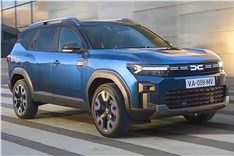Renault Duster review, test drive
Does Renault's small SUV hit the sweet spot? Read our comprehensive and instrumented review.
Published on Nov 26, 2013 04:50:00 PM
1,67,021 Views
Follow us on



In keeping with its small SUV tag, the Duster also uses relatively small engines. Apart from a 1.6-litre petrol motor, the Duster comes with Renault’s popular 1.5-litre K9K diesel engine. With an SOHC for its eight valves, this four-cylinder motor may not be cutting-edge in terms of technology, but it is a very flexible unit. On the Duster it is available in two states of tune – 84bhp and 108.5bhp – with different injection systems and turbochargers responsible for the varied power output. The more powerful version tested here, THP in Renault-speak, features seven-hole Piezo injectors, a variable-geometry turbocharger (as opposed to the fixed-geometry turbo on the 84bhp version) and also comes with an intercooler. Prior to the Duster’s launch in India, the THP engine received updates to improve drivability in the form of a simplified air-intake path and new low-inertia turbo.
The Renault Duster 110 feels responsive enough and power builds smoothly from as low as 1500rpm with a stronger shove around the 2000rpm mark. That’s not to say the engine is free from turbo lag. Driving up the twisty hill roads, we had to keep shifting down from third gear to second to maintain momentum. For the record, this motor churns out its 25.3kgm of peak torque at 2250rpm. Thanks to the engine’s broad spread of power, even part-throttle responses are good and you can actually pull cleanly from 30kph in fifth gear. But to get the most out of this engine, you need to stay within the 2000-4000rpm band. Hold gear and the engine will crawl further to its 5000rpm redline, at which point it does sound quite thrashy. In fact, in terms of overall refinement, the engine is just about average. The Duster 85 on the other hand is better for city driving with it's almost-zero lag and lighter, more progressive clutch.
The 110 is mated to Renault’s six-speed TL4 manual gearbox, and while it doesn’t require much effort to change gears, the gearshifts are not very precise. A bigger bother is the slightly heavy clutch in the SUV that gets tiring to operate in stop-go traffic. What does help driveability is the short gearing for first, second and third, which allows you to keep the engine on the boil in typical city driving scenarios. In contrast, fifth and sixth gears are tall, to aid relaxed highway cruising; 80kph in sixth gear has the engine spinning at a lazy 1800rpm.
Upcoming
Copyright (c) Autocar India. All rights reserved.



.jpg&w=234&h=156&q=90&c=1)

Comments
Member Login
Personal Details
No comments yet. Be the first to comment.